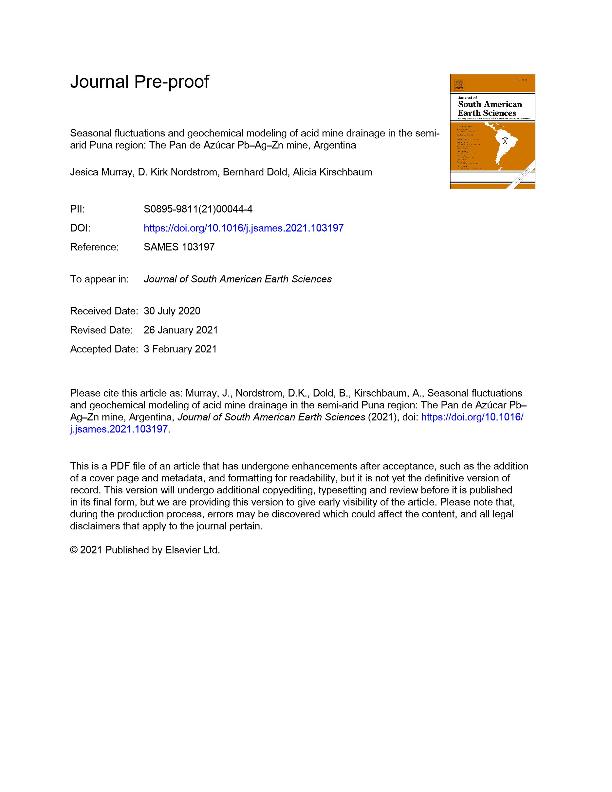Artículo
Seasonal fluctuations and geochemical modeling of acid mine drainage in the semi-arid Puna region: The Pan de Azúcar Pb–Ag–Zn mine, Argentina
Fecha de publicación:
08/2021
Editorial:
Elsevier
Revista:
Journal of South American Earth Sciences
ISSN:
0895-9811
Idioma:
Inglés
Tipo de recurso:
Artículo publicado
Clasificación temática:
Resumen
Pan de Azúcar is an inactive Pb–Ag–Zn mine in the semi-arid Puna region of NW Argentina at 3600 m above sea-level. The mine is situated in Los Pozuelos basin, which is a UNESCO Biosphere Reserve. Substantial pyrite and few carbonate minerals are present in the tailings. The generated acid mine drainage (AMD) has low pH (1.92–4.06) and is mainly Fe–Zn–SO4 type water with high concentrations of metals that in order of relative abundance vary as: Al ≫ Cd > As(T) > Ni > V > Cu > Co > Sb > Cr > Pb > Sn > Ag. The strong annual cycle of dry and wet seasons in the Puna generates a significant influence on AMD geochemistry. In the dry season, there is no runoff and AMD drains mainly in the form of seepages with low pH (1.92–2.21), high concentrations of metals, and the formation of metal-rich soluble efflorescent salts is favored by strong evaporation. At the beginning of the wet season, the efflorescent salts rapidly dissolve and metals concentrations in AMD increase significantly, creating the most hazardous period for the surrounding fluvial environment. At the end of the wet season the pH increases (3.44–4.06) and the concentration of metals decreases, especially arsenic associated with ferric iron precipitates. As a consequence of the DC3 dam restoration, a large volume of AMD is retained forming an acid pond, in which processes of AMD mixing, secondary minerals precipitation, and sulfide oxidation were quantified by inverse modeling with mixing. Jarosite and schwertmannite precipitates in the surface of the pond and favors the attenuation of As and Pb. However, subaqueous oxidation of sulfide minerals, hydrolysis of silicates, and mixing with upstream AMD seepage increases the concentrations of SO42-, Fe(II), and the other metals in the seepage of the pond that migrates downstream. The results of this study indicate the necessity to improve the remediation methods of Pan de Azúcar mine. It is expected that other sulfide mines in the Puna region will have a similar variability of the AMD geochemistry, which should be considered for mine closure, remediation, and monitoring of water quality in mining.
Archivos asociados
Licencia
Identificadores
Colecciones
Articulos(IBIGEO)
Articulos de INST.DE BIO Y GEOCIENCIAS DEL NOA
Articulos de INST.DE BIO Y GEOCIENCIAS DEL NOA
Citación
Murray, Jesica María; Nordstrom, Darrel Kirk; Dold, Bernhard; Kirschbaum, Alicia Matilde; Seasonal fluctuations and geochemical modeling of acid mine drainage in the semi-arid Puna region: The Pan de Azúcar Pb–Ag–Zn mine, Argentina; Elsevier; Journal of South American Earth Sciences; 109; 8-2021; 1-50
Compartir
Altmétricas




